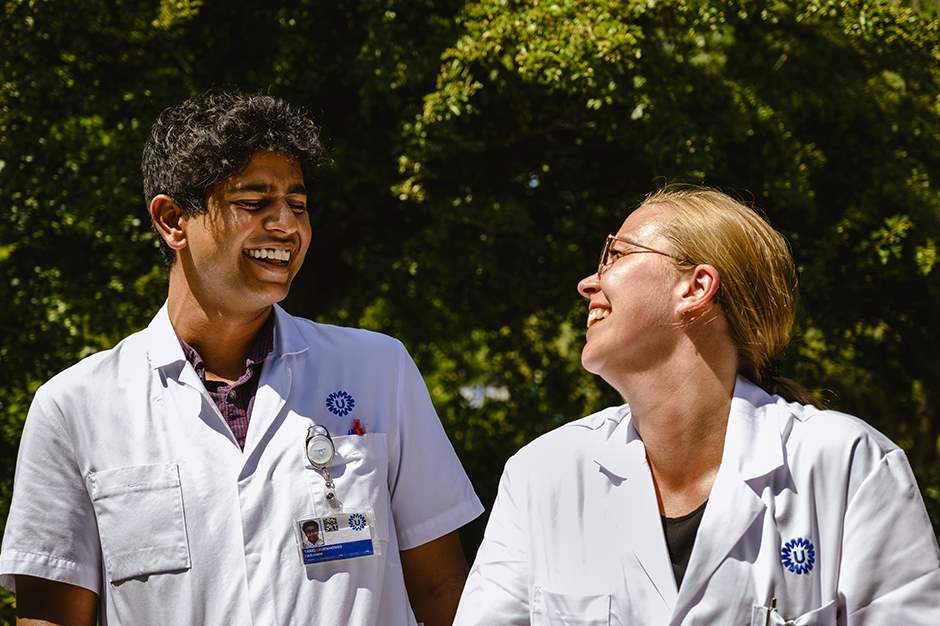Our approach
In our approach to work towards that dot on the horizon, tackle the tasks awaiting us, and reach our goals, there are three important pillars. These are Healthcare of Tomorrow, Fine-tuning our Healthcare Profile, and Creating Financial Scope.
Healthcare of tomorrow
Within our Healthcare of Tomorrow program we are harmonizing our processes based on a new structure where we combine related activities such as outpatients, inpatients, and OR in domains overarching our specialties and divisions. This enables us to create the healthcare of tomorrow through innovation, and thereby keep healthcare affordable and accessible. In this way we can effectively fulfill our role in the healthcare chain and in society, at a regional and country level but also internationally .

The domains represent a chosen structure of processes overarching our specialties and divisions (for example Brain, Heart & Lungs, and Children). Examples of domains are: Inpatients, Outpatients, OR, ED, Lab diagnostics, and Research.
Within the ten domains, in 2023 we formed multidisciplinary design teams (consisting of colleagues from all parts and layers of the organization as well as patients, their families, and students) and reflected on what these processes should look like in 2030. We based this redesign on the following three principles:
-
People-centered: we pay attention to patients, their families, and colleagues.
-
Digital, unless: we are digitalizing in order to offer more and better healthcare.
-
Uniform and modular: by working in the same way we can help each other better.
This gave us a blueprint for the future towards which we want to work gradually by means of process improvements and projects. Important topics within these transformations are:
-
Giving control to patients and their families
-
Preventing consultations and (re)intake
-
Regional cooperation and availability of data
-
The future-proof and flexible deployment of workers
-
Smart labor-saving technology
-
Job differentiation for workers
Based on the process blueprints, we looked at how we could organize ourselves differently. Which digital concepts could offer a solution for future healthcare processes. And which specific criteria and needs the future accomodations of UMC Utrecht must fulfill in order to support future healthcare and working processes. In the end this resulted in a first selection of tangible projects whereby we can effectively take the first steps towards the healthcare of tomorrow. In 2023 we started with preparations for these projects. In 2024 we are starting with the actual implementation. We are also adding new projects using the same method in 2024.
With our Healthcare of Tomorrow program we are following – with our vision as departure point – an integral approach whereby we are tackling our tasks in terms of accomodations, digitalization, and transformation of the organization in an integral way. This puts us at UMC Utrecht as well as our approximately 12,000 colleagues, partners, and patients, on the way to the UMC of the future and healthcare of tomorrow.
Fine-tuning our healthcare profile: towards network care
Our healthcare profile consists of complex care, care that fits within our focal points, and care that we have a statutory duty to provide. Complex care for example includes care that requires the infrastructure or multidisciplinary expertise of an academic hospital. Statutory healthcare refers to care that in accordance with the law may only be provided at a few places in the Netherlands. An example is level 1 trauma care. Care that fits into our focal points mostly involves care for small patient groups with rare diseases. Within these focal points we combine healthcare, education, and research. For this last category, we are recognized through our expertise centers for rare diseases .
The move towards network care as an answer to the demands from society and the Dutch Integral Healthcare Agreement (IZA) that we must be very clear as to where we as UMC Utrecht bring the most value for patients and where we make a difference. Both at a regional and at the country level. In 2023 we reflected on this question with people who are broadly representative of our institution. On which topics and in which role do we have a place in this task and also in the network? Where are we leaders in terms of knowledge and innovation? For which type of care do patients really have to be with us? We also look at what type of care is needed at UMC Utrecht to support that care which we alone are able to provide in the region and countrywide. In 2023 fine-tuned our healthcare profile based on all these discussions, work sessions, and available information. We are rounding off this process in the spring of 2024. Based on the healthcare profile, we will have discussions with other healthcare institutions in the region and countrywide, to give shape to network care through cooperation.
Creating financial scope
The task that awaits UMC Utrecht has an impact on our financial position. The necessary transformation of our organization comes with significant investments. Both in terms of accomodations (renovation= and digitalization and of the transformation of the organization itself. At the same time we are using the opportunities through agreements in the IZA to reach agreements with insurance companies for development scope and therefore extra income. This while the demand for care is increasing in volume as well as complexity. It is therefore essential for us to create financial scope in a timely manner for the investments needed to back these developments and implement our strategy.
Following an extended analysis we launched the ‘Creating financial scope’ program in 2023. The long-term goal of this program is to improve the efficiency of UMC. To achieve this we are focusing in the short term on strengthening the procurement chain in order to save on procurement costs and reduce the cost of hiring staff (not salaried) and consulting services. Parallel to this we are improving our management model and financial management for the long term. In this way we are growing towards a healthy and sustainable operational management that meets all financial standards.